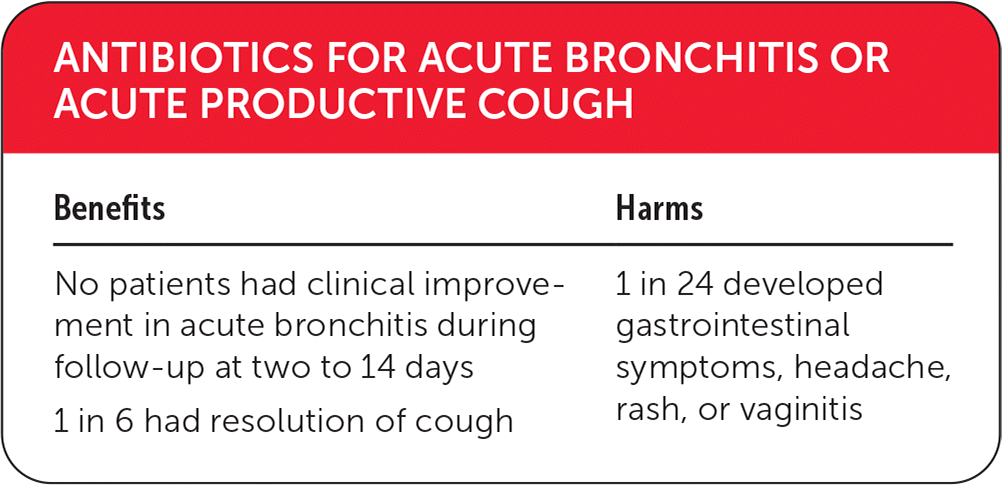
Am Fam Physician. 2020;102(9):online
Author disclosure: No relevant financial affiliations.

Details for This Review
Study Population: Patients with acute bronchitis or acute productive cough with persistent cold or flulike illness
Efficacy End Points: Overall clinical improvement, patient-reported cough symptoms, feelings of illness, and limitations on activity, as assessed during follow-up at two to 14 days
Harm End Points: Adverse effects of antibiotic use (most commonly gastrointestinal symptoms), headache, skin rash, and vaginitis

| Benefits | Harms |
|---|---|
| No patients had clinical improvement in acute bronchitis during follow-up at two to 14 days | 1 in 24 developed gastrointestinal symptoms, headache, rash, or vaginitis |
| 1 in 6 had resolution of cough |
Narrative: Acute bronchitis is a lower respiratory tract infection, most commonly viral, that accounts for a significant number of health care visits (100 million annually in the United States).1 It is characterized by acute onset and persistence of cough for one to three weeks. Reassurance and symptom control are the foundation of care for this self-limited condition; however, studies indicate that 50% to 90% of patients are prescribed antibiotics.2
The Cochrane review summarized here assessed the effect of antibiotics in patients with acute bronchitis.3 The review analyzed 17 randomized trials that compared any antibiotic therapy with placebo or with no treatment. The studies included 5,099 patients of either sex with acute bronchitis or cough, with persistent cold- or flulike illness, and who did not have preexisting pulmonary disease. Most trials excluded patients with clinical findings of pneumonia; four trials excluded patients based on radiographic findings. Eight of the studies enrolled adults, whereas the remainder included children and adolescents of varying ages. Antibiotics included doxycycline, erythromycin, trimethoprim/sulfamethoxazole, azithromycin (Zithromax), cefuroxime, amoxicillin, and amoxicillin/clavulanate (Augmentin). In most of the studies, there was a single follow-up reassessment at two to 14 days after the initiation of treatment.
Among 3,841 participants, there was no statistically significant difference in general improvement as assessed by clinicians at follow-up (relative risk [RR] = 1.1; 95% CI, 0.99 to 1.2). This outcome integrated a mix of patient-reported measures from the individual trials (e.g., reduction in severity scores, reported global improvement, decreased limitations, resolution of moderate to severe symptoms). Patients treated with antibiotics were less likely to report cough (RR = 0.6; 95% CI, 0.5 to 0.9; number needed to treat = 6; n = 275). There was also an overall reduction in days with impaired activity (0.5 days; 95% CI, 0.04 to 0.9; n = 767) and days of feeling ill (0.6 days; 95% CI, 0.1 to 1.2; n = 809).
Twelve of the 17 studies (n = 3,496) reported adverse effects. There was a statistically significant increase in adverse effects overall, including nausea, vomiting, diarrhea, headache, rash, and vaginitis (RR = 1.2; 95% CI, 1.1 to 1.4; number needed to harm = 24).
Caveats: The quality of trials was reported as “generally good”. The 17 studies varied in outcomes measured and time of follow-up, and some reported only on the duration of symptoms. There appeared to be a modest statistical effect of antibiotics on some symptom-related outcomes, but these benefits were slight, raising the question of clinical significance.
No benefit was found for the global measure of improvement at follow-up (n = 3,481). The most recently conducted study included in the review (n = 2,061) showed that neither duration of “moderately bad” or “worse” symptoms, nor mean symptom severity, differed between those who received antibiotics and those who did not. Cough and combined-symptom outcomes were not evaluated separately in this trial, so the results could not be incorporated into the meta-analysis of cough. If the results had been incorporated, it seems likely that the demonstrated small benefits in resolution of cough might have disappeared.
In addition, the 17 studies were not uniform as to whether chest radiography was performed before enrollment in the study. Apparent benefits may have resulted from the inclusion of patients who had pneumonia. However, imaging is not commonly performed to confirm acute bronchitis, and limiting the meta-analysis to studies that required chest radiography would have reduced its generalizability.
Conclusion: This review demonstrates that antibiotics provide small benefits in cough and activity level in patients with acute bronchitis. If more recent trials had been included in the subgroup analyses, these benefits may have disappeared. The clinical significance of this is unclear, particularly in comparison to adverse effects, the medicalizing of a self-remitting condition, and broader threats such as antibiotic resistance. Therefore, we have assigned a color rating of red (no benefits) to this treatment.
